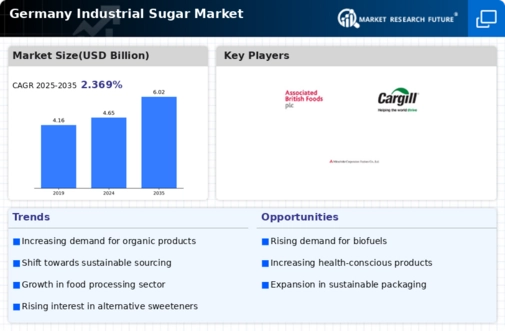Export Opportunities in Emerging Markets
Germany's industrial sugar market is poised to benefit from expanding export opportunities in emerging markets. With a robust production capacity, Germany is well-positioned to supply sugar to countries experiencing rising consumption levels. In 2025, it is estimated that exports could account for around 15% of total sugar production. This trend is driven by increasing demand in regions such as Asia and Africa, where economic growth is leading to higher sugar consumption. The industrial sugar market may leverage trade agreements and partnerships to enhance its export capabilities. Additionally, the growing global demand for sugar in various applications, including food, beverages, and biofuels, presents a lucrative opportunity for German producers. As these markets continue to develop, the potential for growth in exports could significantly impact the industrial sugar market.
Consumer Trends Towards Natural Sweeteners
The shift in consumer preferences towards natural sweeteners is influencing the industrial sugar market in Germany. As health-conscious consumers seek alternatives to refined sugars, there is a growing interest in products derived from natural sources. This trend is prompting manufacturers to explore options such as organic sugar and sugar substitutes. In 2025, it is anticipated that the demand for natural sweeteners could increase by approximately 20%, impacting the overall sugar consumption landscape. The industrial sugar market must adapt to these changing preferences by diversifying product offerings and investing in research and development. While traditional sugar remains a staple, the rise of natural sweeteners may reshape market dynamics, compelling producers to innovate and cater to evolving consumer demands.
Rising Demand from Food and Beverage Sector
The food and beverage sector in Germany is a primary driver for the industrial sugar market. As consumer preferences shift towards sweetened products, the demand for sugar has surged. In 2025, the sector is projected to account for approximately 60% of the total sugar consumption in the country. This trend is fueled by the increasing popularity of processed foods, soft drinks, and confectionery items. The industrial sugar market is likely to benefit from this growing demand, as manufacturers seek to enhance product flavor and texture. Furthermore, the trend towards convenience foods is expected to sustain this demand, as consumers increasingly opt for ready-to-eat meals and snacks. Consequently, the industrial sugar market is positioned for growth, driven by the evolving landscape of consumer preferences in the food and beverage sector.
Regulatory Changes and Compliance Requirements
Regulatory changes in food safety and labeling are shaping the industrial sugar market in Germany. The government has implemented stricter guidelines regarding sugar content in food products, which has implications for manufacturers. Compliance with these regulations is essential for market participants to avoid penalties and maintain consumer trust. In 2025, it is expected that approximately 30% of food products will be subject to new labeling requirements, emphasizing sugar content. This shift may compel the industrial sugar market to reformulate products and enhance transparency in ingredient sourcing. While these regulations may pose challenges, they also present opportunities for innovation and differentiation in the market. Adapting to regulatory changes could ultimately strengthen the position of the industrial sugar market in Germany.
Technological Advancements in Sugar Production
Technological innovations in sugar production processes are significantly impacting the industrial sugar market. In Germany, advancements such as improved extraction techniques and automation in processing facilities are enhancing efficiency and reducing costs. These innovations are expected to increase the yield of sugar from raw materials, thereby meeting the rising demand. For instance, the implementation of precision agriculture techniques is likely to optimize sugar beet cultivation, leading to higher quality and quantity of sugar. The industrial sugar market stands to gain from these advancements, as they not only improve production efficiency but also contribute to sustainability efforts by minimizing waste and energy consumption. As technology continues to evolve, it may further transform the landscape of sugar production, positioning the industrial sugar market for sustained growth.














Leave a Comment